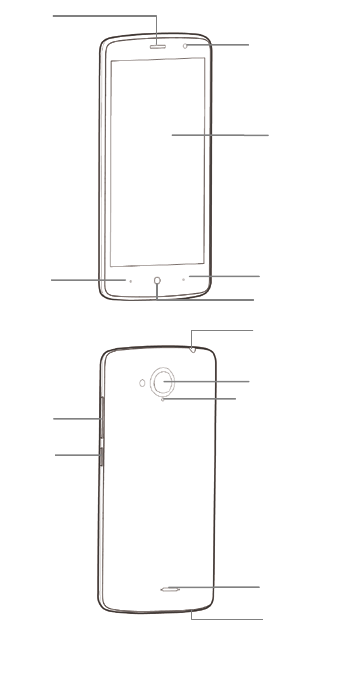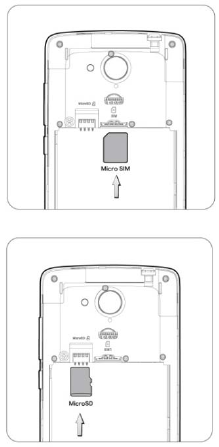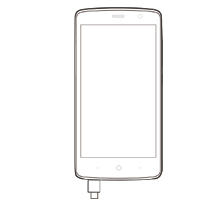ZTE A315 LTE Digital Mobile Handset User Manual
ZTE Corporation LTE Digital Mobile Handset Users Manual
ZTE >
Contents
- 1. Users Manual
- 2. User manual
Users Manual
1
Copyrights
Copyright © 2016 by ZTE Corporation
All rights reserved.
No part of this publication may be quoted, reproduced, translated or
used in any form or by any means, electronic or mechanical, including
photocopying and microfilm, without the prior written permission of ZTE
Corporation.
ZTE Corporation reserves the right to modify technical parameters and
specifications in this guide, and promptly correct the contents in the
guide that are inconsistent with the latest documents. All modifications
shall be compiled in a new version of Quick Start Guide without prior
notice.
ZTE Corporation keeps the right to make the final explanation to this
guide.
Trademarks
Android is a trademark of Google, Inc.
All other trademarks and copyrights remain the property of their
respective owners.
Third-party Applications Statement
During the installation process of some third-party applications, issues
of repeated restart or abnormal operation of software might be caused
by incompatibility of the third-party applications rather than the phone.
Installation of a third-party ROM or non-official operating system might
bring security risk and security threats. ZTE Corporation will not be
liable for the security threats brought by upgrade of the operating
system.

2
Home key
Back key
Headset jack
Back camera
Displa
Receiver
USB port
MICSpe
Front camera
Menu
Noise-reduction
Volume
Power/Rese
t
Getting to Know Your Phone

3
Inserting SIM card and Memory card
Please make sure that the phone is powered off before proceeding.

4
Charging the Battery
Connect the charger to the phone using a USB cable, and plug the
charger into a standard power socket.
Health and safety
FCC Regulations:
This mobile phone complies with part 15 of the FCC Rules. Operation
is subject to the following two conditions: (1) This device may not cause
harmful interference, and (2) this device must accept any interference
received, including interference that may cause undesired operation.
This mobile phone has been tested and found to comply with the limits
for a Class B digital device, pursuant to Part 15 of the FCC Rules.
These limits are designed to provide reasonable protection against
harmful interference in a residential installation. This equipment
generates, uses and can radiated radio frequency energy and, if not
installed and used in accordance with the instructions, may cause
harmful interference to radio communications. However, there is no
guarantee that interference will not occur in a particular installation If
this equipment does cause harmful interference to radio or television
reception, which can be determined by turning the equipment off and
on, the user is encouraged to try to correct the interference by one or
more of the following measures:
5
-Reorient or relocate the receiving antenna.
-Increase the separation between the equipment and receiver.
-Connect the equipment into an outlet on a circuit different from that to
which the receiver is connected.
-Consult the dealer or an experienced radio/TV technician for help.
FCC Note:
Caution: Changes or modifications not expressly approved by the party
responsible for compliance could void the user‘s authority to operate
the equipment.
RF exposure information (SAR)
This phone is designed and manufactured not to exceed the emission
limits for exposure to radio frequency (RF) energy set by the Federal
Communications Commission of the United States.
During SAR testing, this device was set to transmit at its highest
certified power level in all tested frequency bands, and placed in
positions that simulate RF exposure in usage against the head with no
separation, and near the body with the separation of 10 mm. Although
the SAR is determined at the highest certified power level, the actual
SAR level of the device while operating can be well below the
maximum value. This is because the phone is designed to operate at
multiple power levels so as to use only the power required to reach the
network. In general, the closer you are to a wireless base station
antenna, the lower the power output.
The exposure standard for wireless devices employing a unit of
measurement is known as the Specific Absorption Rate, or SAR.
The SAR limit set by the FCC is 1.6W/kg.
This device is complied with SAR for general population /uncontrolled
exposure limits in ANSI/IEEE C95.1-1992 and had been tested in
accordance with the measurement methods and procedures specified
in IEEE1528. This device has been tested and meets the FCC RF
exposure guidelines when tested with the device directly contacted to
the body.
The FCC has granted an Equipment Authorization for this model phone
with all reported SAR levels evaluated as in compliance with the FCC
6
RF exposure guidelines. SAR information on this model phone is on file
with the FCC and can be found under the Display Grant section of
www.fcc.gov/oet/ea/fccid after searching on FCC ID: SRQ-A315.
For this device, the highest reported SAR value for usage against the
head is 0.365 W/kg, for usage near the body is 1.392 W/kg.
Simultaneous RF exposure is 1.499W/Kg.
While there may be differences between the SAR levels of various
phones and at various positions, they all meet the government
requirements.
SAR compliance for body-worn operation is based on a separation
distance of 10 mm between the unit and the human body. Carry this
device at least 10 mm away from your body to ensure RF exposure
level compliant or lower to the reported level. To support body-worn
operation, choose the belt clips or holsters, which do not contain
metallic components, to maintain a separation of 10 mm between this
device and your body.
RF exposure compliance with any body-worn accessory, which
contains metal, was not tested and certified, and use such body-worn
accessory should be avoided.
Declaration of RoHS compliance
We’re determined to reduce the impact we have on the environment
and take responsibility for the earth we live on. So this document allows
us to formally declare that the A315, manufactured by ZTE
CORPORATION, fully complies with the European Parliament’s RoHS
(Restriction of Hazardous Substances) Directive 2002/95/EC, with
respect to all the following substances:
(1) Lead (Pb)
(2) Mercury (Hg)
(3) Cadmium (Cd)
(4) Hexavalent Chromium (Cr (VI))
(5) Polybrominated biphenyl (PBB)
(6) Polybrominated diphenyl ether (PBDE)
Our compliance is witnessed by written declaration from our suppliers.
This confirms that any potential trace contamination levels of the
substances listed above are below the maximum level set by EU
2002/95/EC, or are exempt due to their application.
7
The A315 manufactured by ZTE CORPORATION, meets all the
requirements of EU 2002/95/EC.

8
Disposal of your old phone
1. When the wheelie bin symbol is attached to a
product, it means the product is covered by the
European Directive 2002/96/CE.
2. All electrical and electronic products should be
disposed of separately from normal household
waste via designated collection points provided by
government or local authorities.
3. The correct disposal of electrical and electronic
products will help protect the environment and
human health.